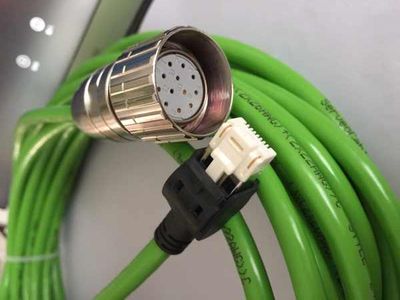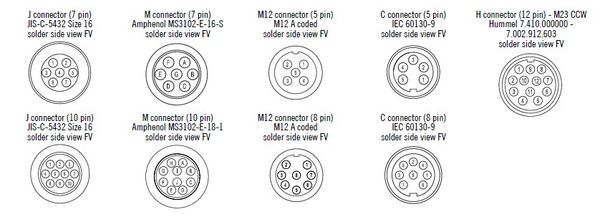CONTENTS:
- Encoder connection types
- What Is Important When Selecting Encoder Wiring?
- Pros & Cons of a Pigtail Connection
- Terminal Strips and Their Specifics
- Connectors for Encoders and Their Diversity
- How to Provide Encoder Wiring in Accordance With Safety Requirements
Encoder connection types
When choosing encoders for industrial systems, lots of features should be considered to gain a brilliant result that is accurate positioning and precise measurements. Among these features, the type of encoder cable connection is of particular importance.
Depending on the type of encoder, it is connected either directly to a computer or to a special programmer using an interface. With the help of which the operability of the encoder is checked. In the event of an encoder malfunction, in most cases, it is replaced. In such matter encoders are divided into:
- Incremental encoder,
- Absolute encoder,
- Parallel encoder (rare),
- Serial encoder (widespread).
Rotary encoder wiring is provided via cables with various types of terminations. Let's consider, what features should be taken into account when buying the encoder and its connection parts.
What Is Important When Selecting Encoder Wiring?
- The level of protection. For correct transmission of the data gathered by the encoder, the connection should be maximum protected from water and dust infiltration along with vibration resistance.
- Easy mounting and use are also important as these factors allow to save time and get working equipment without an invitation of a pro.
- Space parameters also matter as some wiring types require more space.
- The budget. It is a key factor for overall equipment choice.

Then, it is necessary to decide which type of tip will suit the encoder. There are 3 basic options available:
- a pigtail tip,
- various types of connectors,
- terminal strips.
Let's consider each type in details.
Pros & Cons of a Pigtail Connection
A pigtail termination is characterized by wiring that is connected to the encoder permanently as it is soldered to the equipment when manufacturing it. Some kinds of pigtails can be waterproof if they are sealed in a PVC cable, in other options, wires of a pigtail are unsealed. Another end of this connection type has lids to be connected to a drive.
Pros of that connection type are the following:
- It's easy to mount,
- It requires a low budget.
If talking about cons, the main and the most considerable is that in case of wire defect, all encoder should be dismounted to replace the wire.
Terminal Strips and Their Specifics
This type of connection refers to terminal block use. It means that the wire is screwed to the terminal block for instance. From one side, terminal strips provide versatile options for encoder connection. From another, it requires time and skills to connect it right. You should know exactly how to connect the encoder via terminal strips.
Besides, this connection type is not errorless.
Connectors for Encoders and Their Diversity
Connectors are of wide use today. They allow a user to disconnect the cable and connect it any time if needed. When manufacturing, encoders are equipped by a special pin type that suits a certain connector type. For cables, a connector hose can be installed both on the factory or by a user.
There are various types of connectors used for encoders. We'll enclose the most widespread ones.
- Heavy-duty MS connectors with round section and fine threads. This type of connector is suitable for encoders that work in hard working conditions. Be sure you've chosen an MS connector with soldered threads and aluminum alloy as it is the only option that is suitable for encoders. This type of connector has its drawbacks as they require time for installation and its threads could be damaged. Yet, it is quite a widespread type and it is the best for hazardous environments.
- Connectors of M12 type also have a round section with threads soldered. Yet it has a quick-lock principle implemented and it is easier to install than MS-type connectors. Due to its compact diameter of only 12 mm it requires less space. This type is also if a high protection level that allows to use it in high humidity, temperature extremes and harsh environments. As usual, this connector is used with absolute encoders.

- M17 connectors are guided by the same principle as M12 connectors. Yet they are waterproof, easy-locked and light in weight. That allows using them in wet environments.
- M23 connectors are designed for rotary encoder connection to servo motors and electrical motors in industrial systems. They are well-protected and besides, they allow to transmit signals and power supply via the same wiring.
- Bayonet connectors are also quite popular. They protect the whole system from plugging the cable into the wrong pin. Besides, it provides simple locking of the connected wire when placed to the right pin. The locking principle is easy – connection is locked if turned clockward to a quarter.
- Sub-D connectors are among the most compact solutions. Yet, their mounting principle requires access to the encoder housing. As they have low-levelled protection, they are usually used in integrated systems with low space available and normal environmental conditions.
When you have defined the type of connection suitable for your application, the following step is to get through the encoder wiring diagram that is usually provided via the manufacturer's manual.
How to Provide Encoder Wiring in Accordance With Safety Requirements
Here we have some tips on how to provide encoder wiring in a safe mode.
- Please, adhere to the pinout provided by the manufacturer of encoders in the technical guidance documentation supplied with the equipment.
- Use cable channels to provide additional protection for wiring and to create a safe and reliable system. No free-lying cables allowed.
- EMI can distort the signal transmitted by a cable. So please use EMI shielding measures to avoid signal distortion.
- Place ground wires separately from another cabling. Do not allow ground loops.
- In quadrature incremental encoders, additional wiring adjustment for correct phasing is required.
It is necessary to consider that encoder cable diagrams are not similar for various types of encoders. The proper wiring diagram is depicted in the manual guide provided by the manufacturer. Do not use a datasheet from another manufacturer even if you connect encoders of a similar type.
Blocking EMI influence is also important. Every wire has its side effect that is, besides providing a signal, each wire also attracts other radiation. Similarly to the antenna. In long-term use, the attraction of EMI has a cumulative effect and it distorts the signal and makes data irrelevant. So a proper shielding either with foil cover or by braided wires is required.
Then the proper grounding is required. Grounding cable should be the only one as in another case, a ground loop may occur.
Taking into account all this information, you'll be eager to make the right choice and to get your encoder wired and protected properly.
In our webstor you can buy Eltra Encoders with all types of connection. Call our managers to get more information.


